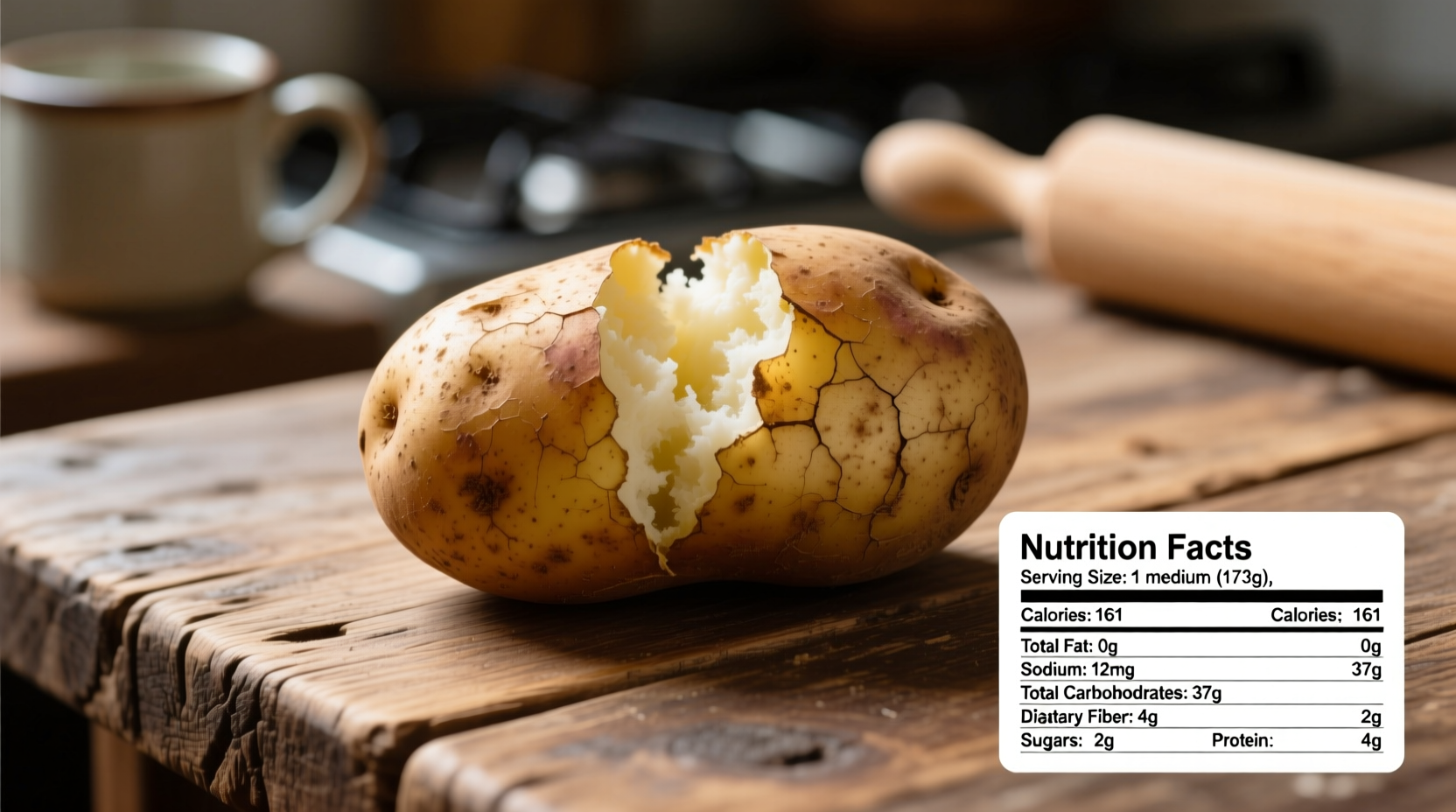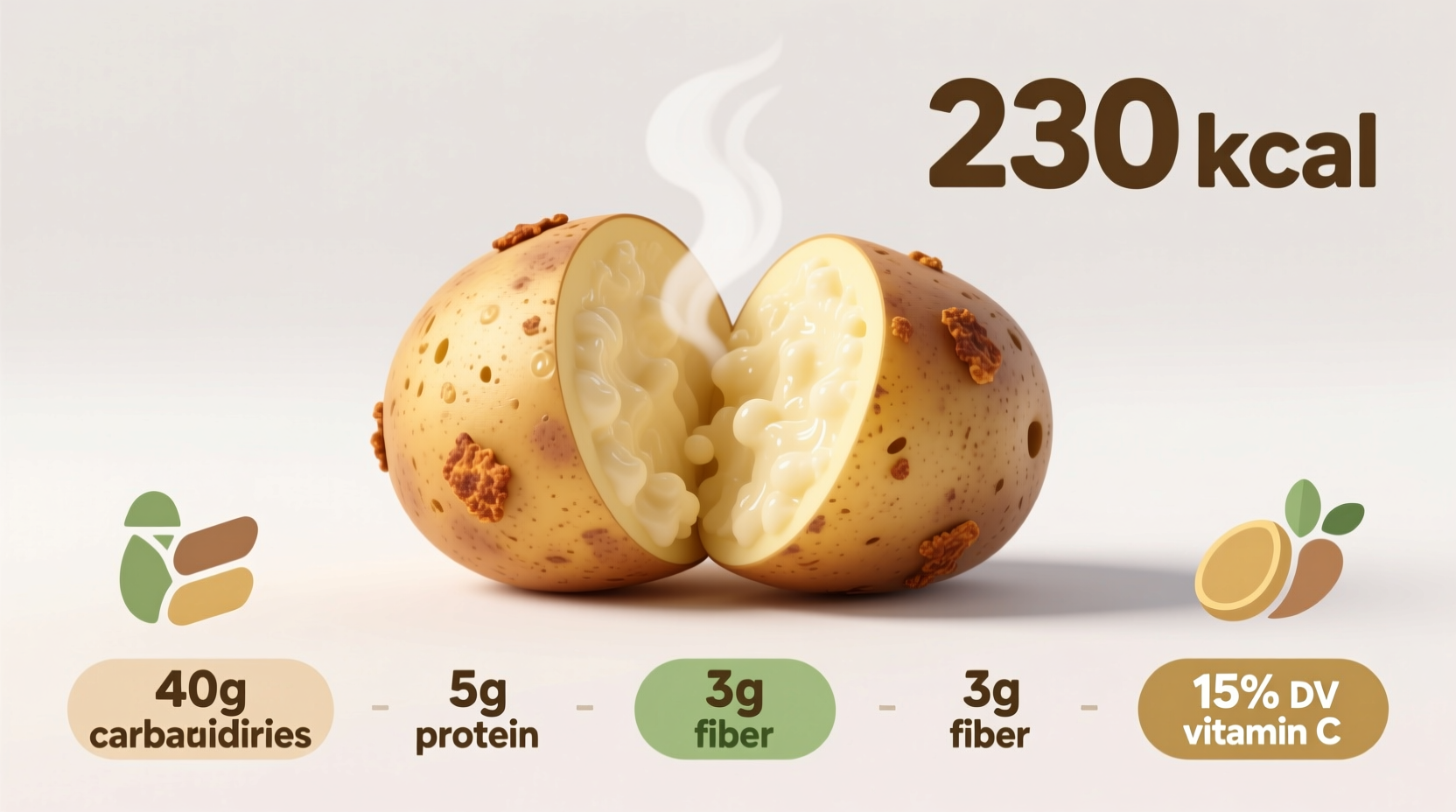Understanding Baked Potato Calorie Variations
When you're tracking your daily intake, knowing the precise calorie count in a baked potato matters. The USDA FoodData Central database provides the most reliable measurements for this staple food. Let's break down exactly what affects the calorie content.
Size Matters: Calorie Count by Potato Dimensions
| Size Category | Weight (grams) | Calories | Carbohydrates | Fiber |
|---|---|---|---|---|
| Small (baseball-sized) | 130g | 134 | 30g | 2.1g |
| Medium (computer mouse-sized) | 150g | 161 | 37g | 3.6g |
| Large (softball-sized) | 270g | 278 | 63g | 4.7g |
| Jumbo (extra-large) | 360g | 369 | 83g | 6.1g |
This factual对照 table from the USDA FoodData Central shows how dramatically size impacts nutritional content. Many people underestimate portion sizes, leading to inaccurate calorie tracking. When dining out, restaurant portions often equal 2-3 medium potatoes, potentially doubling or tripling your expected intake.
How Preparation Affects Calorie Content
The beauty of baked potatoes lies in their versatility, but additions significantly alter the nutritional profile. Understanding these context boundaries helps make informed choices:
- Plain with skin: 161 calories (medium potato) - maximizes fiber and nutrient retention
- Without skin: Approximately 20% fewer calories but loses valuable fiber and nutrients
- With 1 tbsp butter: Adds 102 calories (total: 263)
- With 2 tbsp sour cream: Adds 52 calories (total: 213)
- Loaded with cheese and bacon: Can easily exceed 400 calories

Nutritional Benefits Beyond Calories
Baked potatoes offer impressive nutritional value that extends far beyond their calorie count. According to research from the Harvard T.H. Chan School of Public Health, they're an excellent source of:
- Vitamin C: One medium potato provides about 28% of your daily requirement
- Potassium: Contains more potassium than a banana (926mg vs 422mg)
- Vitamin B6: Essential for brain health and metabolism
- Dietary fiber: Especially when eaten with skin, supporting digestive health
- Antioxidants: Particularly in colored varieties like purple potatoes
Baked Potato vs. Other Potato Preparations
When considering how many calories does a baked potato have compared to other preparations, the differences are substantial. This comparison helps contextualize why baking remains the healthiest cooking method:
- Baked potato (medium): 161 calories
- French fries (medium serving): 365 calories
- Mashed potatoes (1 cup): 237 calories (without added butter/milk)
- Hash browns (1 cup): 193 calories
- Instant mashed potatoes (1 serving): 130 calories (but often lower in nutrients)
The frying process significantly increases calorie density through oil absorption, while baking preserves the potato's natural nutritional profile without added fats.
Practical Tips for Health-Conscious Potato Lovers
Understanding how many calories in a baked potato with skin helps you incorporate this versatile food into various dietary patterns. Try these practical strategies:
- Measure portions: Use a kitchen scale initially to understand what 150g looks like
- Keep the skin on: Adds fiber and nutrients while maintaining the same calorie count
- Smart toppings: Choose Greek yogurt instead of sour cream, salsa instead of cheese
- Cool before eating: Chilling increases resistant starch, which has additional metabolic benefits
- Pair with protein: Combine with lean protein sources to balance blood sugar response
When Baked Potatoes Fit Your Dietary Goals
Despite common misconceptions, baked potatoes can support various health objectives when consumed appropriately. The key is understanding portion sizes and preparation methods. For weight management, they provide substantial volume and fiber for relatively few calories, promoting satiety. Athletes benefit from their complex carbohydrates for sustained energy. The glycemic index varies based on preparation - cooling potatoes after cooking lowers their glycemic impact.
Frequently Asked Questions
How many calories in a baked potato without skin?
A medium baked potato without skin (130g) contains approximately 129 calories. Removing the skin reduces both calories and valuable nutrients like fiber and certain vitamins that concentrate near the skin.
Are baked potatoes good for weight loss?
Yes, when prepared simply and portion-controlled. A medium baked potato provides 161 calories with substantial fiber and nutrients that promote fullness. The key is avoiding high-calorie toppings and considering it as part of your overall carbohydrate intake for the day.
How does cooling affect baked potato calories?
Cooling a baked potato after cooking increases its resistant starch content, which has fewer available calories (about 2-3g fewer digestible carbs per 100g). While the total calorie count remains similar, the metabolic impact changes, potentially improving blood sugar response and providing additional gut health benefits.
What's the lowest calorie way to prepare a baked potato?
The lowest calorie preparation is baking with skin and serving plain or with minimal additions like herbs, vinegar, or a small amount of mustard. This maintains the natural 161 calories for a medium potato without adding fats or sugars that significantly increase the calorie count.











 浙公网安备
33010002000092号
浙公网安备
33010002000092号 浙B2-20120091-4
浙B2-20120091-4